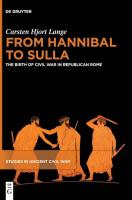
De Gruyter (2024) h/b 230pp £73.00 (ISBN 9783111333090)
Historians following Sallust, Tacitus and Cassius Dio tend to locate the origins of Rome’s 1st C BC civil war in the destruction of Carthage in 146 BC, with the loss of Rome’s greatest enemy resulting in the loss of domestic harmony. L. takes a longer, more complex view, tracing the causes of civil conflict back to the Second Punic War and the edgy relationship between Rome and her Italian subject-allies, for whom and of whom she was afraid. These years were, he argues, an antebellum period with a series of crises—the Bacchanalian Affair of 186 BC (in fact, an emergency manufactured by the Senate and with its roots in disloyal allies’ support for Hannibal); the conflict at Patavium of 174 BC; the rebellion of Fregellae in 125 BC; the killing of Tiberius Gracchus; and the Social Wars—escalating into the conflict between Marius and Sulla, the latter’s capture of Rome in 88 BC, and what was effectively a continuous civil war which lasted until 29 BC. Indeed, L. argues, the very term ‘civil war’ (bellum civile), although first used by Cicero, was probably invented by Sulla himself, partly to distinguish his own three wars (‘a foreign war against Mithridates, an internal war against the allies, and a civil war against fellow citizens’).
For L. nomenclature is central, and much of this monograph, the first volume in De Gruyter’s new ‘Studies in Ancient Civil War’ series, is taken up with lengthy discussions of the Greek terms stasis and emphylios polemos and of the difference between a bellum civile, domesticum and intestinum. Not unsurprisingly, no Roman calls a conflict with foreign enemies or non-Roman Italian states a bellum civile, and the terminology for wars predating 88 BC reflects the shifting relationship between Rome and the rest of the world.
A sound understanding of the terms used to help define the relationship of belligerents is important, however, if we are not only to translate them correctly, but understand how participants or later historians wish to categorise them (‘what we decide to call a conflict is fundamental to our perception of it’)—as evinced, or so L. argues, by the example of the ‘so-called Capitol Riots of 6 January 2021’, ‘so obvious an example of stasis and antebellum, regardless of whether a civil war proper will actually follow it.’ The spectre of this event (which according to L. ‘forever changed US politics’), along with President-elect Biden’s inaugural speech (which ‘may also be viewed in future as a Lincoln moment’) in which he urged Americans to ‘end this uncivil war’, haunts much of the book and discussion of it accounts for most of its first chapter, while parallels with the 19th Century American Civil War crop up not infrequently.
This, then, is a timely discussion, with copious footnotes, 13 pages of bibliography, an index locorum but no index. However, the urgency of the subject matter is not matched by the writing style. I lost count of how many times L. repeated his assertion that ‘the Second Punic War was indeed the last “great” war’ or that the term bellum civile was not invented until Sulla, while even sizeable sections of primary material are repeated in both the original language and English translation (Plutarch’s Moralia 786D–E appears verbatim twice as does Polybius 2.23.12–13 and Thucydides 3.82.1—a crucial passage on stasis, to be sure—is printed in its entirety three times). With its constant reference to the work of other modern historians, it is also, at times, unattractively polemical. Dense, repetitive, extremely specialised, and in need of tighter proofreading, it is likely to be of little or no interest to the general reader.
One final observation: the cover illustration is taken from a Greek vase painting showing the assassination of Hipparchus by Harmodius and Aristogeiton in Athens in 514 BC. It bears no relevance whatsoever to the book’s subject matter.
David Stuttard
